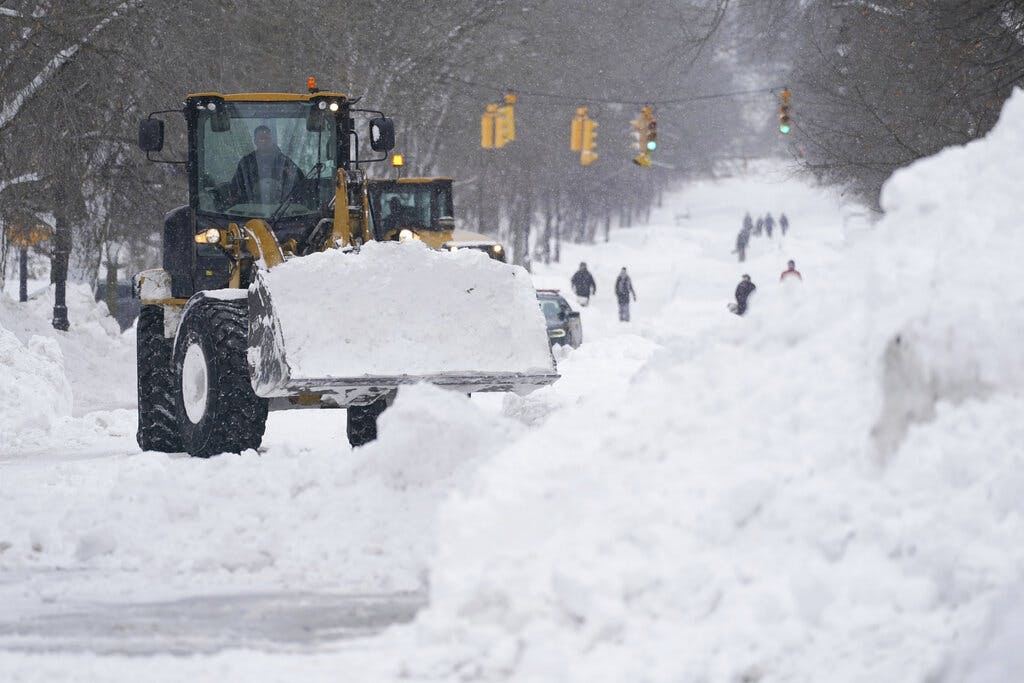NYC Says New Electric Garbage Trucks Are No Match for Wicked New England Weather
New York City officials say the electric garbage trucks it has purchased in the name of combatting climate change cannot do double duty as snowplows — ‘they basically conked out after four hours.’

As the Buffalo, New York, region digs out following a historic snowstorm, lessons are coming in from across the state suggesting that despite advancements in electric vehicles, the future of snow removal is probably diesel.
New York City has set a goal of transforming its fleet of municipal vehicles to be fully electric by 2040, but the 2022 blizzard is sending a reminder that electric vehicles can’t yet do every job.
The commissioner of the New York Department of Sanitation, Jessica Tish, said during a City Council hearing last month that the city’s new electric garbage trucks will not be able to keep up with their diesel predecessors in their secondary function as snowplows.
“In our test of the non-diesel rear-loaders, we found that they could not plow the snow effectively,” Ms. Tish said. “They basically conked out after four hours — we need them to go 12 hours.”
The city has ordered just seven such electric garbage trucks — they cost just more than $500,000 each — a small fraction of the sanitation department’s 2,100 garbage trucks and 6,000 total vehicles. Under the city’s long-range plan to combat climate change, the council has ordered that the vast majority of those vehicles be “clean” energy versions by 2035, with a total conversion to electric vehicles by 2040.
According to the department’s tests, the electric garbage trucks are only able to operate for about four hours when plowing snow, while diesel trucks are able to plow for around 12 to 24 hours at a time.
“Given the current state of the technology, I don’t see today a path forward to fully electrifying the rear-loader portion of the fleet by 2040,” Ms. Tish said.
“Now, things could change, the technology could develop and advance, but I don’t want to sit here and say to you that I see it in my crystal ball today,” she said.
While the Niagara Frontier Transportation Authority, the public transit authority for the Buffalo region, put into use its first electric buses in 2022, neither the Nickel City nor Erie County has announced similar plans.
The reason likely boils down to some of the limitations of electric vehicles — at least in their current state. Despite general advancements in the technology, they underperform in cold weather.
The National Renewable Energy Laboratory, which is overseen by the Department of Energy, predicts that heavy electric vehicles will reach “total-cost-of-driving parity with conventional diesel vehicles by 2035.” The laboratory, however, acknowledges that these predictions are subject to change as electric vehicle technology advances and the cost of fossil fuels fluctuates.
The lab says its predictions are “sensitive to technology improvement trajectories, adoption decision-making, and uncertain assumptions about future freight demand, logistics, and vehicle use.”
What the prediction of “total-cost-of-driving parity” doesn’t address, though, are certain applications for heavy vehicles, like snow removal, which appear unlikely to go electric for the foreseeable future.
Part of the problem is that the range and reliability of electric vehicles suffer in cold temperatures, in part because of the chemistry of the batteries and in part because of the demands of heating the cabin and defrosting windows.
While New York City’s sanitation department found that its heavy electric trucks could only run for about a third of the time of the diesel trucks, all electric vehicles seem to suffer performance-wise in the cold.
A Consumer Reports test of two electric vehicles from 2019 found that electric vehicles had about half of their estimated range in temperatures between 0° F and 10° F. Consumer Reports tested a Tesla Model 3 and a Nissan Leaf in such conditions and found that they used 121 miles and 141 miles of their estimated ranges, respectively, to complete a 64-mile trip.
A senior analyst at the automotive research firm Navigant, Sam Abuelsamid, told Consumer Reports that range reductions in electric vehicles are “largely a factor of increased electrical loads on the battery.”
“Breathing means condensation on cold glass, which requires use of electric defoggers,” Mr. Abuelsamid said. “Longer nights mean more use of headlights. And cold tires, snow, and slush will increase rolling resistance, all of which will reduce range.”
With the shorter range of electric vehicles and the need for specialized chargers, like those used for New York City’s electric garbage trucks, charging could present another challenge for electric plows.
The New York State Thruway Authority, which is responsible for maintaining about 570 miles of thruways across four divisions — New York, Albany, Syracuse, and Buffalo — could run into issues with charging its fleet, were it to be electrified.
The authority operates 11 tow plows, 260 large plows, and 142 small plows. Currently, there are no plans to electrify the fleet.

